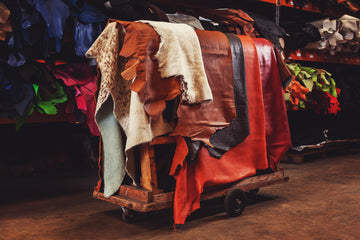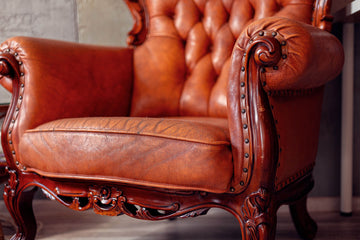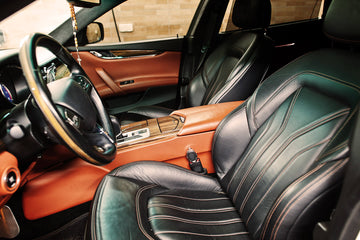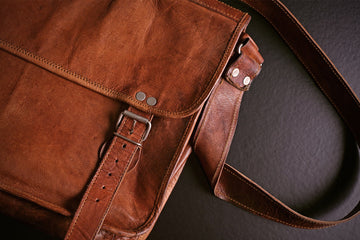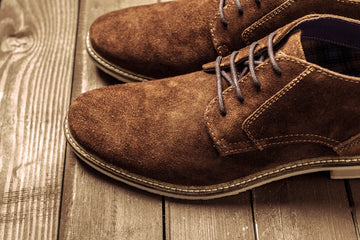When shopping for leather goods, you've likely encountered split leather without realising it. This versatile material appears in everything from affordable furniture to fashion accessories. Yet, many consumers remain unclear about what split leather actually is and how it differs from other types of leather. Understanding split leather can help you make informed purchasing decisions and properly care for the leather products you already own.
Split leather represents a significant portion of the leather market, offering an accessible entry point into genuine leather goods while serving specific functional purposes across multiple industries. This comprehensive guide explains the manufacturing process, including how the animal's skin is split into distinct layers, each with unique qualities and applications. It will also explore different types of split leathers, compare them with other leather materials, and provide practical advice for identifying, using, and maintaining split leather products.
What is Split Leather?
Split leather is produced from the lower fibrous layers of animal hides after the top grain layer is separated by a mechanical splitting process. When thick animal hides ranging from 5mm to 10mm are processed, manufacturers use a leather splitting machine to separate the hide into distinct layers.
The splitting process divides the hide into two or more layers, including the outer layer (the grain side) and the lower layers. The top grain layer, also known as the grain side or outer layer, becomes premium leather, while the lower layers become split leather. This process can produce several layers, each with distinct characteristics.
This type of leather costs approximately one-fifth the price of full-grain leather, making it an attractive option for budget-conscious consumers and manufacturers. Compared to a full-grain piece, split leather is generally less durable and has a different appearance due to the absence of the natural grain surface. The leather industry has utilised split leather production extensively since the 1950s, particularly in furniture upholstery, footwear, accessories, and automotive interiors.
Split leather has a characteristic fibrous texture and lacks the natural grain pattern found in top-layer leather. Unlike full-grain leather, which retains the animal's original surface, split leather's surface is created through various finishing techniques, including embossing, coating, or buffing, to achieve the desired appearance and texture. Drop split and drop split leather are specific types of split leather derived from the lower layers of the hide, often characterised by a rougher texture on both sides and valued for their durability.
The manufacturing process ensures that split leather maintains the essential properties of real leather while offering greater affordability and workability for specific applications. The quality of the split leather used can significantly influence the appearance and value of the finished product. This makes it particularly valuable for products where the soft, pliable nature of leather is desired without the premium cost associated with top grain materials.
How Split Leather is Made - The Manufacturing Process
The creation of split leather involves intricate processes that begin with properly prepared animal hides, primarily cowhide, due to its thickness and availability. The manufacturing process starts after the initial tanning process has begun, when hides are still in their wet state to maintain flexibility during splitting.
A leather splitting machine, typically an electric splitting machine, performs the precise separation of hide layers. These machines use sharp, adjustable blades that can uniformly cut through the hide's thickness while maintaining consistent measurements across the entire surface. The splitting machine must be carefully calibrated because wet hides will shrink significantly during the drying process. The splitting process can produce several layers from a single hide, each with distinct properties.
The process begins with the grain split, which removes the top grain layer containing the original animal's skin surface. This top grain layer becomes the premium grain leather used in high-end products. The remaining lower layer becomes the split leather, characterised by its fibrous structure and open surface texture. One of these layers is sometimes referred to as drop split or drop split leather, which is valued for its durability and unique texture.
After splitting, the split leather undergoes surface preparation through buffing and sanding to create a more uniform texture. Various finishing techniques are then applied depending on the intended use. These may include:
- Embossing to create artificial grain patterns
- Applying protective coatings like PU coating
- Dyeing to achieve desired colours
- Surface treatments to enhance durability
The tanning method used before splitting has a significant impact on the final product quality. Chrome tanning produces more pliable split leather, while vegetable tanning creates thicker leather with different characteristics. The manufacturing process must account for these differences to achieve consistent results across different tanning methods.
Quality control during split leather production involves monitoring consistency in thickness, surface uniformity, and the effectiveness of finishing treatments. Modern facilities can process hundreds of hides daily, making split leather production highly efficient compared to the more labour-intensive processing required for full-grain leather.
Types of Split Leather
The leather industry produces several distinct varieties of split leather, each with specific characteristics and applications. Understanding these different types helps consumers select suitable products for their specific needs and budget considerations.
Other split leathers, such as those used in furniture manufacturing for lower-priced items (often on the outsides or backs to reduce costs), and satchel leather, which has been used since the 1950s for school satchels and is still employed today for realistic leather-like bags, are also common in the industry.
Suede Leather
Suede represents the most recognisable form of split leather, created from the flesh side of the split grain leather with its characteristic soft, napped finish. The finest suede often comes from younger animals, such as calves, which produce a softer, more refined texture compared to adult cowhide suede.
The fuzzy texture of suede results from the exposed fibrous structure of the lower layer, which is then buffed to create the signature nap. This process creates numerous tiny fibres on the surface that give suede its distinctive feel and appearance. Suede shoes, jackets, and fashion accessories remain popular due to this unique tactile quality.
Suede offers superior breathability compared to coated split leather options, making it particularly suitable for leather clothing and footwear where air circulation is important. However, this same porosity makes suede more vulnerable to water damage and staining, requiring specialised care techniques.
The fashion industry extensively utilises suede for accessories, footwear, and apparel, where its soft texture enhances both comfort and aesthetic appeal. Premium suede products often utilise split cowhide from specific regions renowned for producing exceptional hide quality.
Bicast Leather
Bicast leather represents an engineered approach to split leather production, where the split leather is pressed with polyurethane or vinyl layers to create a more durable and uniform surface. This process, developed in the 1950s, allows manufacturers to create products that visually resemble grain leather while maintaining cost efficiency.
The polyurethane layer is often embossed to mimic the appearance of natural grain leather, creating consistent patterns that full-grain leather cannot match. This uniformity makes bicast leather particularly attractive for furniture manufacturing, where matching large surface areas is important for aesthetic consistency.
Bicast leather offers improved water resistance compared to untreated split leather, albeit at the expense of some breathability. The synthetic coating also provides enhanced durability against surface wear, extending the useful life of products made from this material.
Common applications include furniture upholstery, automotive interiors, and accessories, where appearance consistency and moderate durability are more important than premium feel or longevity. The coating process enables precise colour matching and consistent finish across large production runs.
Bonded Leather
Bonded leather utilises leather scraps and recycled leather materials, combining them with polyurethane or latex binders to create a composite material. The leather fibre content in bonded leather typically ranges from 10% to 90%, with higher percentages generally indicating better quality and performance.
This manufacturing approach maximises the use of leather materials that would otherwise become waste, making bonded leather one of the most affordable leather options available. The process involves shredding genuine leather pieces and reforming them with synthetic binders into sheets that can be processed like traditional leather.
Bonded leather products often feature embossed surfaces that simulate the appearance of higher-grade leather materials. While bonded leather retains some characteristics of real leather, including a natural leather scent, its performance characteristics differ significantly from those of solid leather materials.
The durability of bonded leather depends heavily on the percentage of actual leather content and the quality of binding agents used. Higher-quality bonded leather can provide satisfactory performance for light-use applications, while lower-grade versions may deteriorate quickly under normal use conditions.
Applications include budget furniture, low-cost leather goods, and products where leather appearance is desired but premium performance is not required. The affordability of bonded leather makes it accessible for consumers who want genuine leather products at minimal cost.
Split Leather vs Other Leather Types
Understanding how split leather compares to other leather materials helps consumers make informed decisions based on their specific needs, budget, and performance expectations.
Split Leather vs Full Grain Leather
Full-grain leather represents the highest quality leather available, utilising the outermost layer of the animal hide with its intact grain structure. This fundamental difference in source material creates significant disparities in performance, appearance, and cost between full-grain and split leather products.
|
Feature |
Split Leather |
Full Grain Leather |
|---|---|---|
|
Durability |
3-5 years typical lifespan |
10-50+ years with proper care |
|
Grain Pattern |
Artificial or absent |
Natural, unique patterns |
|
Patina Development |
Minimal ageing characteristics |
Develops rich patina over time |
|
Water Resistance |
Requires treatments |
Naturally more resistant |
|
Tear Resistance |
Lower due to fibrous structure |
Excellent tear-resistant properties |
The grain layer in full-grain leather provides structural integrity that split leather cannot match. Full-grain leather is generally three to five times more durable than split leather, making it suitable for items that will receive heavy use over many years. The natural grain pattern in full-grain leather develops character over time, while split leather maintains a relatively static appearance.
Split leather serves different market needs, offering genuine leather properties at accessible prices for consumers who prioritise affordability over maximum durability. For items such as decorative accessories or moderately used furniture, split leather can provide satisfactory performance at substantial cost savings.
Split Leather vs PU (Synthetic) Leather
PU leather represents a completely synthetic alternative, made from a polyurethane coating applied to a fabric backing, which creates fundamental differences in material properties compared to split leather derived from animal hides.
Split leather retains the natural breathability inherent in animal skin, allowing for air circulation that PU leather cannot provide. This breathability makes split leather more comfortable for products that come into direct contact with the skin, such as clothing or shoe linings.
The authentic leather smell and feel distinguish split leather from synthetic alternatives. While PU leather can visually mimic the appearance of leather, it lacks the natural characteristics inherent in animal-derived materials. Split leather retains the organic texture and scent that many consumers associate with genuine leather products.
PU leather offers superior water resistance compared to most split leather items, making it suitable for applications where moisture exposure is likely. However, this water resistance comes at the cost of breathability and the natural characteristics of leather.
Durability comparisons depend on specific product applications. High-quality PU leather can outlast lower-grade split leather in certain applications, while premium split leather may offer better longevity than basic synthetic materials. The key difference lies in failure modes: split leather typically wears gradually, while PU leather may crack or peel when the coating fails.
Environmental considerations also differ between these materials. Split leather utilises animal byproducts that might otherwise be discarded, while PU leather relies on petroleum-based synthetics with different environmental implications.
Is Split Leather Real Leather?
Split leather is considered genuine leather, derived from animal hides, and retains its classification as authentic leather despite being of lower quality than top-grain materials. The leather industry recognises split leather as legitimate leather because it contains natural leather fibres and retains many characteristics of animal skin.
The term "genuine leather" is often used to describe split leather products, although this classification can encompass various types of split leather with differing quality levels. Not all leather products labelled as genuine leather offer the same performance characteristics, as this category encompasses everything from high-quality split leather to lower-grade bonded leather materials.
Split leather features the natural fibrous structure found in animal skin, distinguishing it from synthetic leather alternatives. This fibrous structure provides the breathability and natural characteristics that synthetic materials cannot replicate, confirming its status as real leather.
The classification of split leather as genuine leather has important implications for consumers seeking authentic leather products. While split leather lacks the grain surface of premium leather types, it retains the essential properties that define genuine leather: its natural origin, breathability, and organic characteristics.
However, consumers should understand that genuine leather classification does not guarantee premium quality. Split leather products labelled as genuine leather may have shorter lifespans and different performance characteristics compared to full-grain or top-grain leather items, despite sharing the genuine leather designation.
The leather industry's labelling practices sometimes blur distinctions between different leather types, making it important for consumers to research specific product construction rather than relying solely on genuine leather labels when making purchasing decisions.
Common Uses and Applications
Split leather serves diverse applications across multiple industries, with manufacturers choosing this material for its specific advantages in terms of cost, workability, and functional characteristics. Split leather is used in a wide range of products, including shoes, bags, upholstery, and automotive interiors.
Proper care and maintenance are essential for maintaining the longevity and performance of any split leather item.
Furniture Industry
The furniture industry represents one of the largest consumers of split leather, utilising an estimated 60% of affordable leather furniture production. Manufacturers commonly use split leather in budget-friendly sofas, recliners, and chair upholstery, where cost control is essential for market competitiveness.
Split leather applications in furniture often focus on non-contact areas, such as chair backs and sides, where durability requirements are lower than those for high-wear surfaces. Other split leathers are also frequently used on the outsides or backs of furniture to further reduce costs, especially in lower-priced items. This strategic approach enables manufacturers to offer genuine leather furniture at affordable price points while concentrating higher-grade materials in areas that receive direct use.
Many furniture manufacturers combine split leather with higher-grade leather types for cost-effective manufacturing. Contact surfaces, such as seat cushions, may utilise top-grain leather for durability, while visible but non-contact areas employ split leather to maintain the leather aesthetic throughout the piece.
The furniture industry benefits from split leather's workability during the manufacturing process. Split leather's softer texture makes it easier to form around furniture frames and creates fewer wrinkles during upholstery installation compared to stiffer full-grain materials.
Quality furniture makers often treat split leather with protective coatings to enhance both durability and consistency of appearance. These treatments can significantly extend the useful life of furniture upholstered with split leather while maintaining cost advantages over premium leather options.
Automotive Industry
Automotive applications utilise split leather extensively for interior components where leather aesthetics are desired without premium costs. Approximately 10 million steering wheels are manufactured annually, incorporating split leather elements, particularly in the economy and mid-range vehicle segments.
Split leather is frequently used in car door linings, headrests, and dashboard trim applications, where direct contact is minimal but the leather appearance enhances perceived value. The automotive industry values split leather's consistency in colour and texture, which facilitates matching across multiple interior components.
Even luxury vehicles sometimes incorporate split leather in non-contact interior surfaces, allowing manufacturers to maintain leather interiors while controlling costs. The key lies in strategic placement where split leather's limitations don't affect functionality or user experience.
The automotive industry often treats split leather with specialised coatings to enhance UV resistance and durability in the challenging automotive environment. These treatments help split leather withstand temperature extremes and sun exposure that would quickly degrade untreated materials.
Manufacturing efficiency represents another advantage for automotive applications. Split leather's uniform thickness and predictable properties simplify automated manufacturing processes used in high-volume automotive production.
Fashion and Accessories
Fashion applications favour split leather for products where softness and flexibility are more important than maximum durability. The pliable nature of split leather makes it particularly suitable for creating comfortable and attractive leather clothing, bags, and accessories.
The sneaker industry commonly uses split leather for improved breathability compared to synthetic materials. Split leather linings in athletic footwear provide moisture management and comfort advantages while maintaining cost efficiency for mass-market products.
Leather accessories, such as belts, wallets, and handbags, frequently incorporate split leather, especially in budget-friendly product lines. Split leather bags offer genuine leather construction at prices accessible to a broader consumer market, although buyers should be aware of the durability limitations compared to full-grain alternatives.
Craft projects and leatherworking workshops often prefer split leather for learning applications. The material's lower cost makes it suitable for practice projects, while its workability allows beginners to develop skills without investing in premium materials.
Split leather items in fashion applications benefit from the material's ability to take dyes and finishes effectively. This allows for diverse colour options and surface treatments that might be more difficult or expensive to achieve with higher-grade leather materials.
Quality Assessment and Durability
The quality of split leather varies significantly based on multiple factors, including the source of the hide, processing methods, and finishing techniques. Understanding these quality indicators enables consumers to evaluate split leather products effectively and set realistic expectations for performance and longevity.
The fibrous structure inherent in split leather creates reduced tensile strength compared to grain leather types. This structural characteristic means split leather is more susceptible to stretching, tearing, and surface damage under stress. However, quality split leather can still provide satisfactory performance for appropriate applications.
Higher-quality split leather features a consistent texture across its entire surface, indicating proper processing and finishing. Premium split leather products exhibit uniform colour distribution and a smooth surface, with no visible processing marks or irregularities.
The source of animal hides significantly affects split leather quality. Hides from younger animals typically produce finer, more consistent split leather, while hides from older animals may have varying thickness and texture that affects the final product quality.
Processing methods during tanning and splitting influence long-term durability. Vegetable-tanned split leather often exhibits better ageing characteristics than chrome-tanned alternatives, although both tanning methods can produce high-quality results when properly executed.
Protective coatings and finishing treatments can significantly enhance the durability and performance of split leather. Quality manufacturers apply specialised treatments that improve resistance to wear, moisture, and staining while maintaining the material's natural characteristics.
The leather derived from different animal species produces varying quality levels in split leather. Split cowhide generally offers good durability for most applications, while splits from other animals may have different characteristics that affect performance expectations.
Identifying Split Leather Products
Recognising split leather products requires understanding specific visual and tactile characteristics that distinguish this material from other types of leather. Consumers who can identify split leather can make informed purchasing decisions and avoid misconceptions about product quality.
The most obvious indicator of split leather is its fibrous texture and absence of natural grain patterns. Unlike top grain leather, which displays the unique grain structure of the original animal's skin, split leather shows a consistently fibrous surface that may be embossed with artificial patterns.
Split leather feels thinner and less substantial than top-grain leather when handled. The material typically has a softer, more pliable feel due to its fibrous structure, though this can be modified by surface treatments and coatings applied during manufacturing.
Product descriptions often provide clues about split leather construction. Terms like "split," "bicast," or "genuine" leather often indicate split leather products, although genuine leather can encompass a range of quality levels within the split leather category.
Visual appearance can reveal split leather through uniform surface characteristics that contrast with the natural variations found in grain leather. Split leather often displays consistent colour and texture patterns that result from embossing or coating processes rather than natural hide variations.
The super flat surface sometimes seen on coated split leather products indicates artificial finishing rather than natural leather characteristics. This consistent surface appearance lacks the subtle irregularities that characterise genuine grain leather surfaces.
Product labelling practices vary among manufacturers, with some clearly identifying split leather while others use ambiguous terms. Understanding common terminology helps consumers interpret product descriptions and identify the actual materials used in construction.
Care and Maintenance Guide
Proper care significantly extends the life and appearance of split leather products, though maintenance requirements differ from those needed for full-grain leather due to structural and surface differences. Regular maintenance is crucial for maintaining the integrity of any split leather item, preventing damage and extending its lifespan.
Cleaning Split Leather
Regular cleaning prevents the accumulation of dirt and surface damage that can prematurely age split leather products. Use a soft, damp cloth with mild leather cleaner every 2-3 months for routine maintenance, adjusting frequency based on use intensity and environmental exposure.
Testing cleaning products on an inconspicuous area is essential before applying them to visible surfaces. Split leather can react differently to cleaning agents compared to grain leather, and some products may cause discolouration or surface damage if incompatible with specific finishes.
Avoid harsh chemicals and excessive water exposure during cleaning, as split leather's porous structure can absorb moisture that leads to damage or staining. Water-based cleaners should be used sparingly and followed by thorough drying to prevent moisture-related problems.
The cleaning process should focus on surface dirt removal without aggressive scrubbing that could damage the fibrous structure. Gentle circular motions, combined with the use of appropriate cleaning products, effectively remove most surface contamination without causing structural damage.
Allow split leather items to air dry completely before applying any conditioning treatments or resuming regular use. Proper drying prevents moisture retention, which can cause mould, mildew, or structural deterioration over time.
Conditioning and Protection
The conditioning requirements for split leather differ from those for full-grain leather due to surface treatments and structural characteristics. Apply specialised split leather conditioner every 6 months to maintain flexibility and prevent cracking, though some coated split leathers may require different treatment schedules.
Products designed specifically for suede finishes are necessary when caring for suede-type split leathers. These specialised conditioners maintain the nap texture while protecting against staining and wear without compromising the characteristic suede appearance.
Petroleum-based products can damage protective coatings applied to split leather surfaces. Choose conditioning products specifically formulated for split leather or test their compatibility before applying to ensure the treatments enhance rather than degrade the surface finishes.
A leather conditioner application should follow manufacturer recommendations for specific product types. Over-conditioning can cause surface damage or alter appearance characteristics, while under-conditioning may lead to cracking and premature ageing.
Storage considerations significantly impact the longevity of split leather. Store split leather items in a cool, dry place away from direct sunlight, as this can cause fading and surface deterioration over time. Proper storage prevents environmental damage that shortens product lifespan.
Climate control helps maintain split leather condition during storage and regular use. Extreme temperature variations and humidity changes can cause cracking, warping, or other types of damage, which can be prevented with proper environmental control.
Conclusion
Split leather plays a crucial role in making genuine leather products accessible to diverse consumer markets while maximising the utilisation of animal hides in leather production. Understanding what split leather is and how it differs from other leather materials helps make informed purchasing decisions that align product features with their intended uses.
The manufacturing process that creates split leather from the lower layers of thick animal hides produces a material with distinct characteristics that differ significantly from full-grain and top-grain leather. While split leather lacks the durability and ageing characteristics of premium leather types, it offers genuine leather properties at substantially lower costs.
Various types of split leather, including suede, bicast, and bonded leather, serve different market needs and applications. Each type offers specific advantages for particular uses, ranging from the soft texture of suede to the consistent appearance of bicast leather, ideal for furniture applications.
The sustainability aspects of split leather production demonstrate both benefits and challenges. While split leather maximises hide utilisation and can reduce processing requirements, shorter product lifespans may increase replacement frequency and associated environmental impacts.
When considering split leather products, evaluate your specific needs for durability, appearance, and budget to determine whether the characteristics of split leather align with your requirements. Proper care and maintenance can significantly extend the life and appearance of split leather items, maximising value from these affordable, genuine leather products.
The future of split leather lies in continued improvements to processing methods, finishing techniques, and sustainable production practices that enhance performance while maintaining cost advantages. As consumer awareness grows, transparent labelling and clear quality distinctions will help buyers make informed choices about split leather products.
Why Buy Leather From Us?
At Rolford Leather, we pride ourselves on being the UK's leading leather supplier, offering comprehensive knowledge and quality materials to help you make informed leather choices. Our extensive split leather selection includes genuine suede for shoes and jackets, bicast leather for affordable furniture, and coated splits perfect for bags and accessories.
🔗 Discover our split leather range
We understand the importance of choosing the right leather type for your specific needs and budget. That's why we provide detailed information about split leather characteristics, helping you understand how it compares to full-grain and synthetic alternatives. With competitive pricing, expert guidance, and transparent quality descriptions, we ensure you know exactly what you're purchasing.
🔗 Learn about our leather grades
How to Buy Split Leather Online?
Looking to purchase split leather for your next project? Whether you need suede for footwear, bicast leather for budget-friendly sofas, or split leather for wallets and belts, our collection offers genuine split leather products at various price points. Browse our selection with detailed specifications and care instructions for each type.
🔗 Shop split leather collection
Need help determining if split leather is right for your application? Contact our experts for personalised advice on leather selection. From understanding the differences between suede and bicast leather to learning proper maintenance techniques for split leather products, we're here to help you make confident decisions about your leather purchases.
